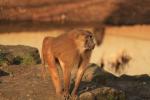Guinea Baboons
Guinea baboons are found in grassy, rocky, and steppe habitats in western Africa. They live in troops of up to 200 individuals, each with a set place in a hierarchy. Group living provides protection from predators such as lions and hyenas. Baboons are omnivores, eating almost anything available, which allows them to occupy areas with few resources or harsh conditions. Their presence may help improve habitats because they dig for water and spread seeds in their waste, encouraging plant growth.
Baboons live everywhere in Africa where they can find drinking water. They have dog-like muzzles and limb modifications which allow them to walk long distances on the ground.
Baboons can be an important food source for other animals. Some of the largest eagles will feed on them or their young. The African crowned hawk eagle will often hunt in pairs. One swoops and perches among a troop of baboons, and while they mob it, the mate swoops from behind and picks up an unwary baboon.
Mother-daughter bonds among baboons last into adulthood. The maternal bond with sons lasts until sexual maturity, when juvenile males leave their natal group to enter another group or become solitary.
The social structure of Guinea baboons is multi-levelled. Adult males maintain separate social units, containing females, juveniles, and sub adult males.
Guinea baboons are highly communicative animals. They communicate with one another by using a variety of vocalizations and physical interactions. In addition to vocalizations to one another, these animals have vocal communications apparently intended to be received and interpreted by predators.
|















